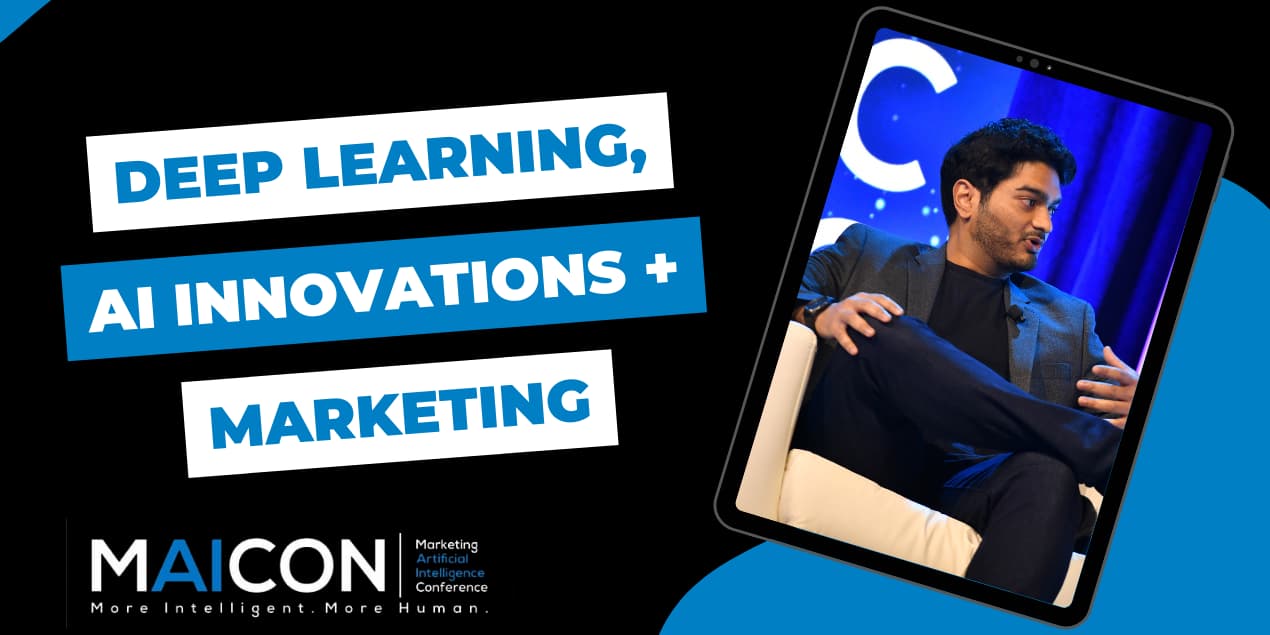From inside the research labs of some of the most innovative AI companies in the world—HubSpot, OpenAI, and his current role at Google—Vedant Misra has worked on many of the AI advancements that are redefining marketing, business, and society.
We ended MAICON 2022 with a fireside chat where Marketing AI Institute CEO Paul Roetzer explored how Vedant went from studying neutrinos, black holes, and the cosmic microwave background at Columbia University to generating customized sales and marketing content at his deep-learning startup, Kemvi, which he sold to HubSpot in 2017.
Opportunities abound for marketers who are learning about artificial intelligence and its role in the marketing landscape. Learn more from this educational and exciting conversation between Paul and Vedant.
Watch Vedant Misra's MAICON 2022 Fireside Chat with Paul Roetzer
Watch this full session plus all MAICON main stage keynotes, sessions, and panels with the MAICON 2022 On-Demand Bundle.
When marketers think about innovative technologies and industry-leading companies to watch, Google and HubSpot are certainly at the top of the list. When next-gen marketers think about innovative technologies, OpenAI has become a household name. Vedant Misra has worked (or currently works) at all three.
Misra explained, "The main story of the last five years in this space has been that we can take very simple methods and not make too many modifications at all and just scale them up to extremely large models and extremely large data sets. And these systems just keep getting smarter and smarter.
And we've seen a succession of these systems developed, starting with GPT-2, which caught people by surprise, which had 1.5 billion parameters."
You can think of a parameter as a number. The more parameters a number has, the more information it can absorb. Comparing a model to the brain, a parameter is a synapse. The more synapses, the bigger the brain. Similarly, the more parameters a model has, the more information it can absorb.
As mentioned, GPT-2 had 1.5 billion parameters. Let's put that in perspective with GPT-3 at 175 billion parameters and Google's PaLM model at 540 billion parameters.
So these large language models continue to improve. When you increase the model size and increase the sizes of these data sets, these models can pick up on all kinds of things that you would not have anticipated that they would be able to learn, all without explicitly teaching them anything. Increasing parameters has a very simple objective of taking a large dataset and trying to predict, for example, what the next word is going to appear in the data.
Misra said, "One limitation people generally believe these models had was that they couldn't solve reasoning problems, and in particular, that they had a hard time with math problems, math and science problems."
Subsequently, Google released Minerva, showing that with fairly simple methods, we can get a model to solve hard science and math problems at the level of a talented high schooler or an undergraduate.
These impressive advancements in large language models continue to move the timeline forward by several years, helping marketers and business leaders in new and exciting ways.
Key takeaways:
- Before we get to the existential threat of AI, we need to focus on other things, including economic disruption and society's need to adapt so AI can enhance their lives.
- We need to stifle the capabilities of bad actors and keep them from improving. This could be anything from deepfakes used maliciously to developing new kinds of weapons or trying to hack into secure systems.
- No matter how advanced machines get, humans remain uniquely suited to understanding what other humans want. None of these systems has ever learned from interaction with a human in general.
- Marketers' roles have started to shift to learning how to use AI-powered tools effectively and getting the most out of these tools.
Misra ended this fireside chat by saying, "I think there's a lot of cognitive burden that could be lifted off of people and moved to computers, which would then free us up to be creative and to work on other problems that we care more about."
What a great, optimistic outlook on the future of marketing and artificial intelligence, and an excellent way to wrap up MAICON 2022. It's time to think about the role of technology in your career, and the Marketing AI Institute and our community are here to help.
Become a next-gen marketer by checking out the resources at the Marketing AI Institute. Read our blog posts, take our Intro to AI for Marketers class, attend webinars, join our community, download reports, guides, and templates (all free), read Marketing Artificial Intelligence, look into AI Academy for Marketers and Piloting AI Bundle, and attend our annual MAICON—Marketing AI Conference.
Oh, and don’t forget: Get access to all MAICON main stage keynotes, sessions, and panels with the MAICON 2022 On-Demand Bundle.
Cathy McPhillips
Cathy McPhillips is the Chief Marketing Officer at SmarterX and Marketing AI Institute


